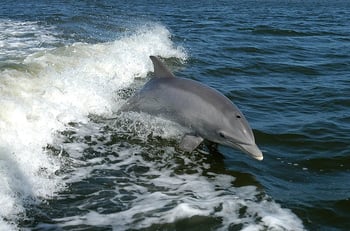Although dolphins swim in water and appear to be "fish-like" compared to other animals living in the ocean, they are classified as cetaceans (marine mammals) and not fish. Evolving sometime around the Eocene Epoch, cetaceans such as dolphins and whales are thought to share a common ancestor with the hippopotamuses. Fossils discovered in Pakistan over 40 years ago confirmed the fact that dolphins transitioned from being land mammals to sea mammals probably due to a rapidly changing environment necessitating adaptation to an aquatic lifestyle.
What Makes Dolphins Mammals?
1. Dolphins are Warm-Blooded
Warm-blooded animals maintain body temperatures higher than environmental temperatures through metabolic processes different from cold-blooded animals. The ability to control body temperature regardless of environment is a characteristic of homeothermic animals, such as dolphins and birds. Evolutionary biologists hypothesize that birds and mammals evolved warm-bloodedness specifically to prevent fungal infections. Cold-blooded animals such as amphibians and reptiles frequently suffer a variety of fungal infections.
2. Dolphins Breathe Through Lungs, Not Gills
Watching dolphins swim in the ocean, you've probably wondered why they continuously make trips to the surface. That's because they are mammals and have lungs much like humans do. When dolphins surface for air, they exhale to blow away water covering their blowholes. The water spray you see coming out of a dolphin's blowhole is not water coming from the lungs but water coming off the dolphin's body. This allows dolphins to inhale oxygen free of water. Additionally, dolphins only breathe through blowholes and never through their mouths. Because a dolphin's eating and breathing
 Dolphins also have collapsible lungs to avoid suffering decompression sickness when they dive deeper than normal. Collapsible lungs allows dolphins to breathe much more quickly than humans. They are able to exchange 80% of the air in their lungs with each breath, while humans are only capable of exchanging 17%. Learning more about how these amazing lungs function under extreme pressure may help researchers develop technologies to reduce risks to humans in similar situations.
Dolphins also have collapsible lungs to avoid suffering decompression sickness when they dive deeper than normal. Collapsible lungs allows dolphins to breathe much more quickly than humans. They are able to exchange 80% of the air in their lungs with each breath, while humans are only capable of exchanging 17%. Learning more about how these amazing lungs function under extreme pressure may help researchers develop technologies to reduce risks to humans in similar situations.
3. Dolphins Give Birth to Live Young
Most mammals give birth to live young. Reptiles, amphibians, fish and insects lay eggs that hatch at some point in the future. Although birds are warm-blooded, they are neither reptiles or mammals but belong in their own group. Sexual maturity of dolphins varies, and is related to the size of the animal, not age. Reproductive maturity will typically occurs at 85 – 95% of their mean adult body length, in most cases, this is between 5 – 12 years of age. A dolphin pregnancy last around 12 months. Female dolphins can realistically bear calves once every 2 to 4 years but the average interval between dolphin births is three years.
4. Dolphins Have Hair
Dolphin calves have hair on their rostrum when they are born, which falls out soon after birth. However, you can still see hair follicles through adulthood. Dolphins do not need hair to maintain body temperature since they have plenty of blubber to keep organs warm. Evolutionary biologists think that the presence of dolphin body hair at birth indicates the ancestors of dolphins (land mammals) had hair to help them maintain body temperature in colder environments. Marine mammals that live on land and in water use fur as a primary means of insulation. However, blubber is the primary means of insulation for most marine mammals, including dolphins.
5. Dolphins Lactate Like Other Mammals
Female dolphins have mammary glands that produce milk even while gestating, meaning pregnant dolphins can feed older calves while waiting for another to be born. Calves typically nurse two to four years and some will remain with mothers for four or five years. Studies into the composition of dolphin milk have found that it does not resemble human milk but is more similar to high-fat milk produced by dogs, reindeer and rabbits. What is interesting about dolphin milk is that it is extremely low in lactose, which differs from dog, rabbit and reindeer milk. In addition, calves can drink milk from their mother's teet while under water because they can manipulate their tongues in a "straw" like formation to form a seal over the mother's nipple.
Although social behavior is not considered a definitive characteristic of a mammal, the fact that dolphins are large, brained dolphin species and engage in an intricate social network may be another reason why dolphins are categorized as mammals instead of fish. Even more remarkable is that Atlantic bottlenose dolphins show an evolutionary convergence of cognitive and social features similar or equal to other large-brained mammals (e.g., primates).








